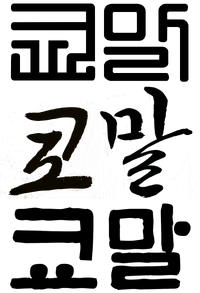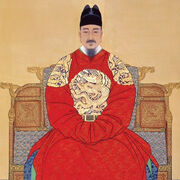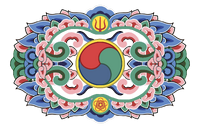| Kyomal | |
|---|---|
|
쿄말 Kyomal | |
 쿄말 ('Kyo language') written in the Kyo script in different fonts. From top to bottom: seal script, flowing script, and palace script. | |
| Region | Dovani |
| Ethnicity | Kyo |
| Native speakers | 87 million (3600) |
| Language family |
Kyo-Changtae |
| Dialects | Gongmangdo (Standard), Nambyeon, Myeoggi, Seongtaek, Southeastern, Northwestern, Yingdalan, Jobyeon |
| Writing system | Kyogul and Yeongja |
| Official status | |
| Official language in |
|
| Recognised minority language in | Yingdala, Sekowo, Midway |
| Regulated by | National Institute of the Kyo Language |
| Language codes | |
| ISO 639-1 | ky |
| ISO 639-3 | kyo |
The Kyo Language (쿄말, Kyomal), is the official language of Dankuk and is one of the two still-extant members of the Kyo-Changtae Language Family, alongside the Changtae Language.
Kyo is a mixed-script language, making use of both the native Kyogul script as well as Yeongja, or Gao-Indralan characters as used in Dankuk.
Dialect Differences[]
Main article: Differences between Munhwa O and Pyojun O
There are significant disparities between speakers of Southern and Northern Kyo. Though mutually intelligible; pronunciation and vocabulary are significantly removed; giving a non-native speaker a very hard time communicating with a southerner or a northerner.
Writing System[]
Overview[]
Kyomal makes use of two writing systems, Kyogul and Yeongja.
Yeongja[]
Yeongja (英字/영자) are Gao-Showan characters as adapted to the Dankukian context. Generally, Dankuk tends to use older and more traditional forms of these characters than is found in other languages employing the script such as Indralan and Kunigo. Yeongja literacy is required to learn the Kyo language to a proficient degree.
Kyogul[]

King Saejong of Bae, the ninth king of the Kingdom of Bae and the inventor of the Kyo alphabet
The Kyo Alphabet (-㐎/쿄글) was invented by King Saejong of Bae in the year 972 CE. It is one of the only featural alphabets in use in Terra; meaning that the letters looks similar to how they are pronounced and formed in the body. The script is world-renowned for it's simplicity, elegance, and convenience.
Kyogul isorganized into syllabic blocks. Each block consists of at least two of the 24 Kyogul letters, with at least one each of the 14 consonants and 10 vowels. These syllabic blocks can be written horizontally from left to right as well as vertically from top to bottom in columns from right to left.

|
Gao-Showans | |
| Peoples | Central: Kunihito • Sekowans • Kyo | Northern: Utari • Welang | Southern: Indralans • Đinh • Phra • Suman | Western: Tukarese • Mu-Tze • Bianjie | |
| Languages | Gao-Indralan: Kunikata • Sekowan • Indralan • Đinh • Phra • Suman• Utari | Jelbo-Tukaric: Panmuan • Bianjie | Other: Kyo | |
| Regions | Dovani • Seleya • Gao-Soto • Sekowo • Dankuk • Indrala • Tukarali • Jinlian • Dalibor • Great North Dovani Plain • Kalistan • Bianjie • Hanzen | |
| History | Empire of Gao-Soto • Kingdom of Sekowo • History of Sekowo • History of Indrala • History of Dranland • History of Tukarali • Great Sekowian War • Southern Hemisphere War | |
| Religion | Gao-Showan Religions • Daenism • Mazdâyanâ • Zenshō • Kamism • Guidao • Jienism • Kanzo | |

|
大拜花國 Kingdom of Great Bae | |
| Geography • History • Culture • Economy • Government | ||
|---|---|---|
| History | Baekgu Dynasty • Beonyeongsalm Palace • Dranland • Dranian Zenshō Revolution • Egelian Drania • Flag of Dankuk • Great Kyo Revolution • House of Ryeo • House of Santiago • Kyobando Manifesto • Kyo-Indralan Revolutionary War • August Revolution • Dranian Civil War • DNWA • Republican Period • Baek Restoration • Timeline of the History of Dankuk | |
| Subdivisions | Provinces: Metropolitan Cities: Capital City: | |
| Politics | President of Dankuk • Chairman of the Council of Ministers • National Congress • Constitution of Dankuk Political Parties | |
| Demographics | Religion: Aurorian Patriarchal Church • Daenism • Seodongyo • Sindo • Zenshō Ethnicity: Majority: Kyo Minority: Draddwyr • Draniano | |
